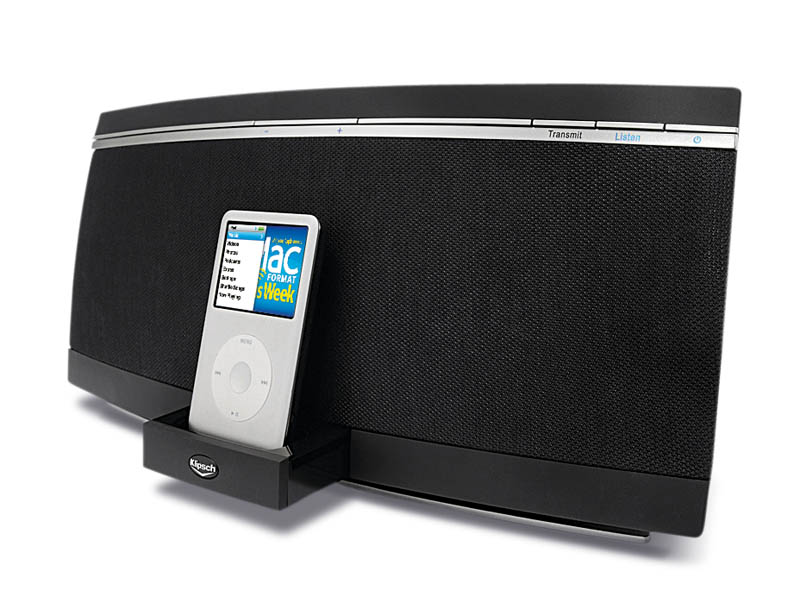TechRadar Verdict
It has excellent wireless communication but the bass is prone to distortion at volume, and there's no battery option
Pros
- +
Fast, lossless wireless network
- +
Superb sound in the mid and high ranges
- +
Very simple to set up wireless network
Cons
- -
Motorised iPod tray seems pointless
- -
Bass handling could be better
- -
Expensive to build a wireless network
Why you can trust TechRadar
Klipsch's RoomGroove speakers work either as standalone iPod speakers or as part of a network of speakers wirelessly connected from room to room.
To establish the network you need to buy additional RoomGroove speakers or other Klipsch audio gear that is KlipschCast enabled, such as the CS-700 Home Theatre.
KlipschCast uses a proprietary 2.4GHz standard that prohibits other brands of speakers from joining the network, but this standard brings benefits including easy setup between multiple Klipsch units and instant wireless speeds.
Establish a network
The RoomGroove boxes are transceivers, meaning each can send and receive audio. They have slide-away iPod trays, so any one RoomGroove speaker can be the audio source inside the network.
This need not be an iPod. A 3.5mm audio-in jack on the back panel will take any source you connect. Two discreet buttons to the upper left side of the front panel switch the box from Listen to Transmit modes, with obvious changes in function.
We used two RoomGrooves to establish a network and placed the boxes in different rooms. Because the boxes only look for other Klipsch equipment, there was no configuration to handle and the connection was established instantly.
With both RoomGrooves switched on we put an iPod into one and pressed Transmit, then pressed the Listen button on the other, and that was that.
Strong signal
The makers claim the signal range covers a 100ft radius, which is accurate.
The signal covered all corners of our terraced house, at any rate, and there was no discernible latency between audio playing back on the receiving box or the transmitting one, and no noticeable loss in quality.
The front speaker grille is fabric-lined and removes to reveal four drivers, two 2.5-inch bass drivers and two tweeters recessed into a horn.
The RoomGroove has a tuned port (opening) at the back of the box where air can escape, and this throws extra bass out.
Impressive sound quality
The sound quality is suited to certain types of music. RoomGrooves can go very loud but if you push them with bass-heavy music the bass will loosen and distort quickly.
At low volumes – as a desktop speaker next to your Mac, for example – the bass kept its shape better. At all volumes, acoustic music, well-produced pop, folk, classical and other mostly mid- and upper-range sounds positively sang.
A remote offers basic functions and is a palm-sized stick. It only offers line of sight control, and was not a great performer around walls or partitions. You can use it to switch signals from the wireless to wired input sources, and to control iPod tracks.
Power options
There are a few negative points. The lack of a battery bay means you're restricted to using the speakers indoors. Also, the wireless features only come into play if you buy two or more boxes, and at £200 per unit this is an expensive proposition.
The sound quality on offer is as good as any £150 speaker we've heard, but the extra expense of the wireless circuitry reduces the value of the box unless you're prepared to ante up for a network.
The obvious competitor is Griffin's Evolve, which is slightly more expensive to buy but cheaper to add speakers to. Griffin's speakers don't require a socket plug for power and instead have rechargeable batteries built into them.
Sound quality is better from the Klipsch boxes, though, so it's a trade off. Griffin's speakers also experience latency issues at the edge of the signal range, while Klipsch's don't.
Flimsy build
The build quality of the RoomGroove is fine but the iPod tray is flimsy.
Klipsch has added a motor behind the tray so that it slides out with a swipe of your finger. This seems destined to break at some point, and it means you can only slide away the tray when the speaker is powered.
RoomGroove speakers favour people with significant budgets for a home network, who don't care for bass-heavy grooves and don't need to take the boxes to the garden. On a lower budget Griffin's Evolve is a better choice.

